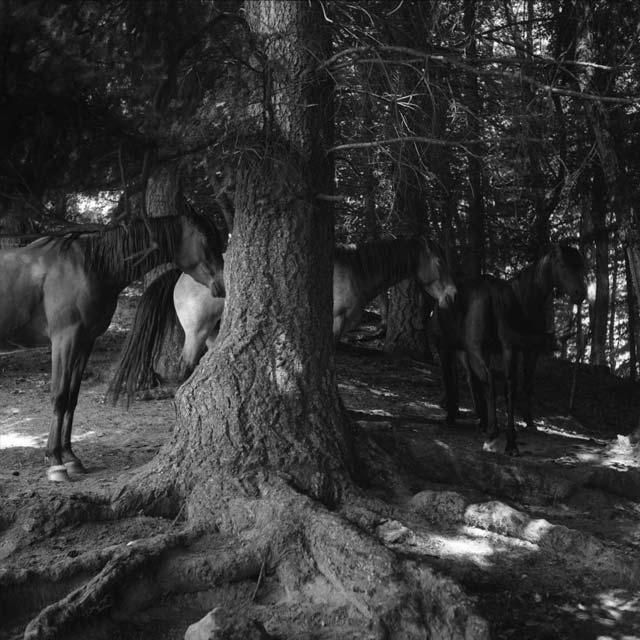H like Horses, since 2012
Ongoing interdisciplinary research project with Dr. Marion Mangelsdorf, cultural scientist (University of Freiburg DE)
Elements:
Methodological Considerations, 2013: text by Marion Mangelsdorf and Ines Lechleitner
Versuchsanordnungen (Experimental Set-Ups), 2013: video, DV-Pal, currently 13.30min, sound
Traces, 2012-2013: series of blind drawings, charcoal on paper done on site with the horses.
Waldszene, 2015: black and white photographic series and wall drawing

stills from video Versuchsanordnungen
"The relationship between man and beast, or more precisely, the question of how a human being and a horse can see ‘eye to eye’, is, in the widest sense, the concern of Ines Lechleitner and Marion Mangelsdorf. The two pursue a special approach, for here we have an artist and a cultural historian joining forces to apply their respective methods of investigation.
Their interdisciplinary project combines the approach of participatory observation with dialectic and visual artistic strategies, with a view to examining the questions of what a non-hierarchical interspecies relationship between man and horse might look like, and how such a relationship might be described. They understand their collaboration and the results as an experiment, which, under the title Experimental Set-Ups explores various aspects of the theme and constantly tries out new approaches and strategies that are summed up in individual chapters. Particular attention is necessarily given to non-linguistic communication, even though a means of exchange regarding the non-linguistic or the physical equally necessarily is once again of a discursive nature. In addition, the methods of Ines Lechleitner, who, as a visual artist, works with drawing, photography and video, provide particular scope for describing the field of investigation."
Excerpt of text by Elke Keiper, director of the Stadtgalerie Waldkraiburg (translation by Josephine Cordero-Sapien).
chapter1 (4.29 min) of the video Versuchsanordnungen, 2012- spoken text (German) mirrors the writing process of the text above: Methodological considerations
The first chapter of the ‘Experimental Set-Ups’ uses a film, which combines photographs, drawings and video and sound recordings, to present the process of collaborative writing, with the help of which their shared research interest and the planned experimental set-up are presented. The next two chapters are based on the encounter between the philosopher and dancer Mónica Alarcón and her phenomenological protocols with one of Ines Lechleitner’s horse drawings, and, further, on the encounter between Alarcón and a horse from the group under investigation.
chapter2 (4.35 min) of the video Versuchsanordnungen, 2012
chapter3 (4.54 min) of the video Versuchsanordnungen, 2012

installation view Versuchsanordnungen,"Körper-Medien-Sinnlichkeit" exhibition, E-Werk, Freiburg 2013
H like Horses
Methodological considerations
Text by Ines Lechleitner and Marion Mangelsdorf
We would like to present here an etho-ethnographic method, which has developed into a participant artistic research process. As a phenomenological sociologist and fine artist, our common starting point is human-horse interaction. The focus of our etho-ethnographic research is a group of between eight and twelve horses. They live in the open all the year round, in summer on extensive pastures in the southern Black Forest and in winter in an open stable.
Etho comes from ethology, comparative behaviour research. Ethnography is considered here to be a sociological method. Bringing together both methods creates an interdisciplinary bridge between the natural and social sciences and brings both animal and human behaviour into focus. If animal and human actors are taken equally seriously as social inter-actors, it means that both material-physical and discursive aspects can be taken into account in the behavioural observations recorded.
Our participatory-artistic research process develops through a dialogue between different forms of documentation – namely, photography, sound recordings and videos, as well as written and graphic protocols. Thus we address different intermediary spaces: between humans and horses, between material-physical and discursive practices. We thereby make a minimal shift from being adjacent to facing one another.
Questions arise about translation and transformation: is it possible to describe a third language between humans and horses? How can the research process be formulated in a dialogue between etho- and ethnography, between science and art?

installation view Traces,"Körper-Medien-Sinnlichkeit" exhibition, E-Werk, Freiburg 2013
Ines Lechleitner considers her audio visual recordings as a parallel method comparable to the approach of the phenomenological protocol.
The charcoal drawings Traces are an exemple for this approach. They are made by Lechleitner on the fields with the horses. The eyes follow the horses' movements and lead the hand in the drawing, which is never looked at during this process.

detail of Traces, 2012-2013

Workshop Developing Methods mit Marion Mangelsdorf and Mónica Alarcón at the university of music and performing arts, November 2014, Vienna
Waldszene, 2015 / click on image to navigate

Waldszene: black and white photographic series and wall drawing





